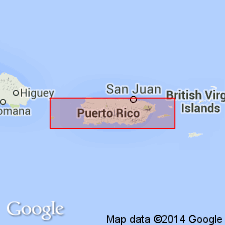
- Usage in publication:
-
- Boqueron Basalt*
- Modifications:
-
- Named
- Dominant lithology:
-
- Lava
- Breccia
- Tuff
- Basalt
- AAPG geologic province:
-
- Caribbean region
Summary:
The Boqueron Basalt is here named in southwestern Puerto Rico. It was previously mapped as San German Formation by Mattson (1960). The Boqueron consists of dark gray-brown to greenish-brown or gray porphyritic, locally amygdular, pyroxene-olivine-oxyhornblende basaltic lava and minor breccia and tuff with poorly developed flow banding. Pillows have not been observed. Thin limestone lenses lie at the top of the basalt. Epiclastic sandstone overlying the Boqueron is interbedded with volcanic sandstone or tuff of the Lajas Formation. The Boqueron appears to underlie the Lajas with only a minor disconformity. Age is Late Cretaceous, middle Campanian or older.
Source: GNU records (USGS DDS-6; Reston GNULEX).

- Usage in publication:
-
- Boqueron Basalt*
- Modifications:
-
- Overview
- AAPG geologic province:
-
- Caribbean region
Summary:
The Boqueron Basalt occurs in southwestern Puerto Rico and consists of dark grayish-brown, locally amygdaloidal, non-pillowed, porphyritic basalt flows. Maximum estimated thickness is 150 meters. The Boqueron is of Late Cretaceous(?) age.
Source: GNU records (USGS DDS-6; Reston GNULEX).
For more information, please contact Nancy Stamm, Geologic Names Committee Secretary.
Asterisk (*) indicates published by U.S. Geological Survey authors.
"No current usage" (†) implies that a name has been abandoned or has fallen into disuse. Former usage and, if known, replacement name given in parentheses ( ).
Slash (/) indicates name conflicts with nomenclatural guidelines (CSN, 1933; ACSN, 1961, 1970; NACSN, 1983, 2005, 2021). May be explained within brackets ([ ]).

